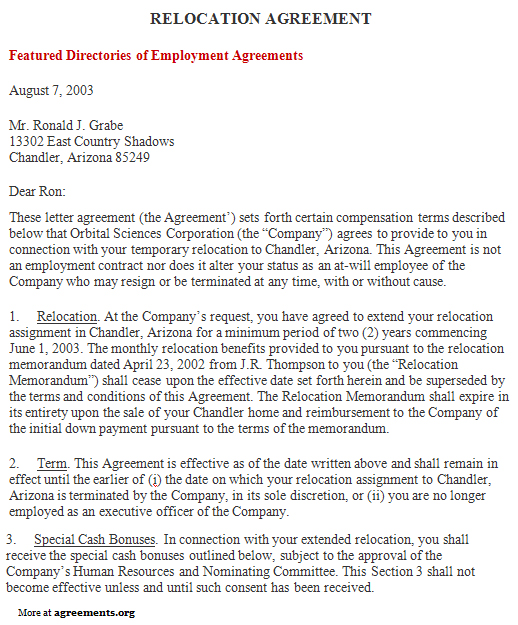Relocation agreements are legal contracts between an employer and an employee when the latter is moving to a new location. Relocation costs are extremely high and include transportation costs of personal belongings, travel costs, rental of new home, admission of children to new school and fine for prematurely terminating the existing home lease. These agreements ensure that the employee does not have any mobility issues because of the financial implications of relocation. Relocation is required when a company has the need for particular skills of an employee in another branch either in the same country or a different country. Though an international relocation is slightly more complex, the underlying logic is the same.
When Do You Need Relocation Agreements
Relocation agreements are required when an employee needs to be transferred from one location to the other. There are substantial costs and hassles involved while relocating which include the costs of transportation, airfare, fees for admission of children to new schools and informing the existing school of the change as well as penalties for premature termination of the lease. As these agreements are between two parties, they are known as bipartite agreements. When a company assists an employee with relocation, the employee is also more willing to relocate as they know that the costs of this exercise and the complications will be taken care of by the employer. It acts as an incentive for the employee and the company benefits as the skill transfer takes place seamlessly.
Inclusions in Relocation Agreements
Relocation agreements must include the names of the company and the employee since they are bipartite agreements. A relocation agreement letter is issued to the employee to ensure that the relocation takes place with mutual consent. These agreements must include the effective date, the details of the expenses being reimbursed, the ceiling on the reimbursement, the exclusions, conditions under which the employee will have to return relocation expenses to the company, and that the responsibility of the employee with regard to taxes payable. The relocation benefits being provided like assistance with selling the existing home, temporary living expenses, moving expenses need to be stated in detail. The governing law of the state under whose jurisdiction this agreement is being drafted needs to be incorporated. Any notices or waiver must be provided in writing.
How to Draft Relocation Agreements
The following points are to be kept in mind while drafting relocation agreements:
- The agreement must include the names of the parties to the agreement and the relationship between them
- The value and the nature of benefits being provided including the conditions which apply for receiving such benefits
- The laws of the state which apply to the agreement and the penalty for violation thereof
- The severability clause should be incorporated whereby if any provision of this agreement is null and void, the remain provisions will continue to be in force
- Waiver of rights of either party will not be considered unless provided in writing
- Any notice should be delivered through authorized mail delivery options to the registered address of either party
- The events which lead to the agreement being null and void should be mentioned in detail
Benefits of Relocation Agreements
The benefits of having relocation agreements are:
- Acts as an incentive to employee: Relocation benefits act as an incentive for employees and they are more willing to relocate to a different location where their services will be required.
- Higher productivity: The employer will benefit from optimizing the potential of the employee at the new location, this will lead to higher profits for the company
- Protection of interest: The terms and conditions with regard to the benefits being disbursed on account of relocation are clearly mentioned in the agreement. The employee knows that the company will not default in the payment of the benefits.
- Avoiding dispute: Since the employer and employee have mutually agreed to the relocation benefits, there will be no dispute at a future date
Types of Relocation Agreements
The types of relocation agreements are:
- Lump sum package: The employer provides a mutually agreed fixed sum to the employee who then chooses to spend it in the best way possible. The amount offered is usually with reference to previous relocation costs paid by the company
- Core-flex model: Under this agreement, the company offers certain core benefits to the employee along with some optional benefits. It is important to keep the HR, Finance and Recruiting departments in the loop to design this package.
- Tiered package: Though similar to a core-flex agreement, the benefits disbursed depends on the position of the employee. This model is attractive to senior executives.
Key Terms of a Relocation Agreements
The key terms of relocation agreements are:
- Relocation timetable: The date within which the relocation must be completed by the employee
- Relocation benefits: The details of benefits like home sale assistance, temporary living expenses, home purchase/lease, tax gross-up, moving expenses and return expenses. Within each subhead, the company will specify the ceiling of benefits being provided and the terms relating to disbursement
- Governing Law: The agreement will adhere to the laws of the state under whose jurisdiction it is being drafted
- Severability: If any provision in this agreement is held null and void by a competent court, then the remaining provisions shall continue in full force
- Waiver: Waiver of any right by either party needs to be given in writing
[Also Read: Relocation Policy Agreement]
If you want to provide some benefits to your employees when they are relocating, relocation agreements are mandatory.
You can download sample relocation agreements here.
Sample Relocation Agreement
